Fred Lancôme
Biography of the Artist
Fred Lancôme (né Fritz Hermann Kaffenburger) was a Belgian-born and Paris-trained designer and sculptor. Scion of a middle class German-Jewish family, he was educated in Germany and in Paris, where he settled in the early 1930s. Caught in the storm of war, Fred and his wife Lucie abandoned their home, family, and design boutique in Paris for America. After the War, now an American citizen, Lancôme continued to design, opening a studio in New York.
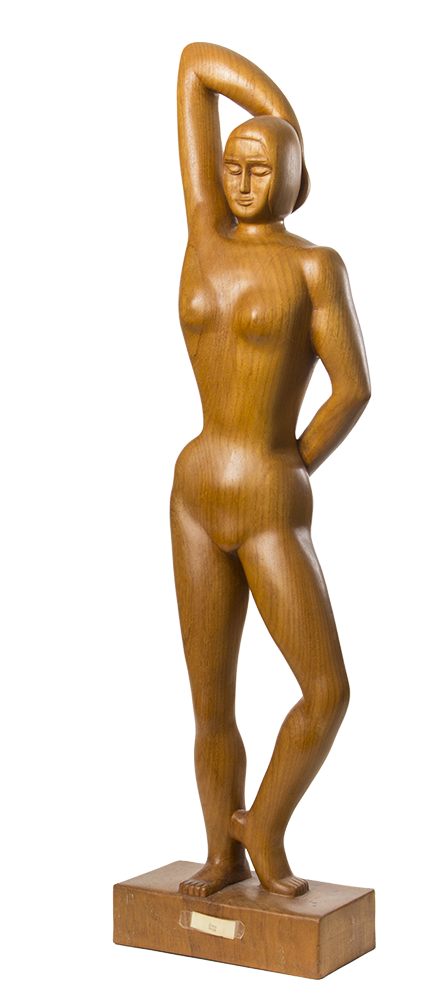
In 1948, seeking a quieter life so as to concentrate on sculpture, he moved to rural Berkshire County, Massachusetts. There, in the town of Monterey, he founded a French-style inn and restaurant, and devoted the off-seasons to art. He became active in the Berkshire Art Association, and began to exhibit in the early 1950s. Lancôme was a founding member of “The Independent Six,” a collaboratlve of Berkshire-area artists in the 1950s.
Despite his conscious choice of an artistic style that was outside the prevailing taste for abstraction, dissonance, and confrontation, his work was praised both domestically and internationally. Lancome’s art is the work of an idealist whose belief in the centrality of human relationships is reflected in figures that are accessible, refined, and beautiful.
“The fluid quality of Fred Lancôme is once again evoked in Awakening, as his use of the curve gives his figure great activity.”
—Stephen J. Fischer, “Two Shows in Lenox,”
The Berkshire Eagle, [Pittsfield, Mass.], 17 July 1956
Art Training and Related Experience
At age 18 Fred Lancome began studies in sculpture and design at the Ecole des Beaux-Arts in Paris (1929-1931). According to a published profile, an instructor “saw him at a sculpture gallery exhibit, noted his strong, supple, sculptor’s hands, and urged him to enter the field.” In the United States, he received further training at the New York studios of Nathan Choate and Bertha Margoles and, in the Berkshires, with Franc Epping. [Berkshire Eagle, 12 Aug. 1961] Fred Lancome began his professional life in Paris as a designer of millinery, and once designed hats for the Comedie Francaise. Surviving photographs of his creations testify to the sculptural quality of his designs. He operated a millinery boutique at 107 av. Victor Hugo, Paris, until 1939, and after 1945 at 19 West 57th St., New York City. He continued working in fashion design until 1948, when he made the decision to focus his artistic energy on sculpture.

Methods and Techniques
Lancôme worked primarily in wood, but also in bronze, stone, plaster, and terra cotta. The process of creating his sculptures was detailed by two writers:
“He is completely convinced that inspiration is the motive power for his creative drive. “For weeks and months, I walk around with an idea taking shape in my mind,” says Lancôme. ‘This is trying. What happens before is harder than the work itself.’ Fred Lancôme makes a dozen or more sketches before he settles on a pose he finds most appropriate. He first makes miniature clay models, which may be worked and reworked until the object fulfills his concept of the finished work. After finishing the final clay model, Mr. Fred Lancôme makes a drawing for orientation as to size and proportion then selects the type of wood best suited to his purpose.
This may be mahogany, teak, ebony, tulip wood, or frequently a white wood which is from the poplar family. Then he carves the final figure in wood, working with hand tools alone, never employing mechanical or electrical aids. The type of wood he uses is determined by the mood he’s trying to represent. Then, he shapes the piece with a mallet and chisel. He finishes off with a rasp, sands the entire figure and applies wax. He is a slow worker, and seeks to complete no more than three or four pieces a year.”
—”Action: Fred Lancôme, sculptor,”
The Berkshire Eagle [Pittsfield, Mass.], 12 Aug. 1961.
—Frederic Kelly, “How do you Compare a Steak to a Sculpture,”
The New Haven Register, Sunday Pictorial, 11 July 1965.
Fred Lancôme
Biography of the Man
Early life in Europe
Fred Lancôme was born Fritz Hermann Kaffenburger at lxtelles (Brussels), Belgium, on 11 February 1911, son of Simon and Selma (Kahn) Kaffenburger, natives of Germany. After the death of Simon Kaffenburger in April 1914 the widow Selma moved into the home of her mother Frieda and brother Jakob in Mannheim, Germany, with daughter Lucie and three-year old son Fred. Fred was educated in Mannheim.
In 1929, Fred took up studies at the Ecole des Beaux-Arts in Paris where he remained until 1931. Details of his course of study, instructors, and status as a student are lacking. What is known from later statements is that he studied sculpture and design there.
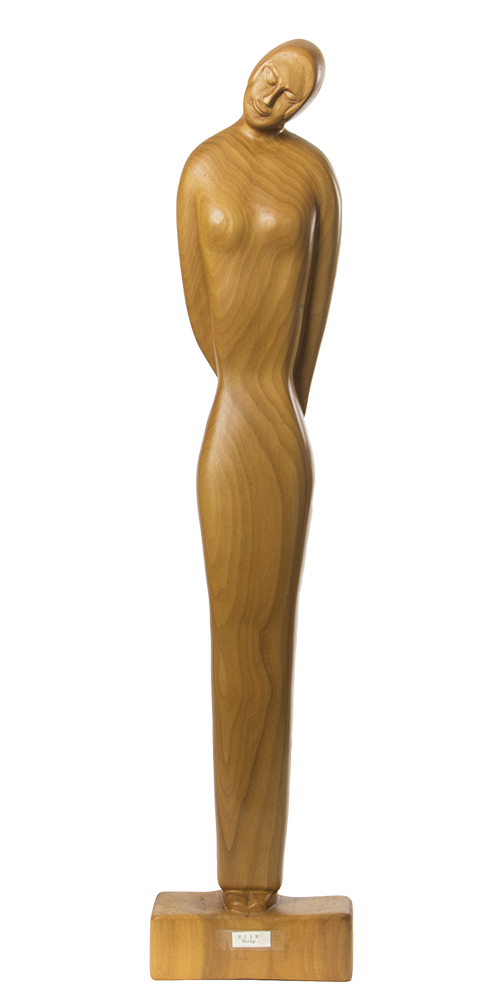
Fred was living back in Mannheim in 1931 when the family moved to Cologne. There is evidence that Fritz may have put his art and design education to practical use assisting architect Bertha Sander. Unfortunately, war damage has erased the details of his activities in Cologne. Fred later recalled that he moved to Paris in 1934.
At the time of his marriage to Lucie Driesen on 9 December 1937, Fred resided at 107 av. Victor Hugo, Paris. Lucie Driesen Kaffenburger was born in Brussels, Belgium, 15 April 1907, the daughter of Willi Driesen, a noted German banker and economist, and his wife Frieda Friedberg Driesen. The Driesen family was living at rue de Passerelle in the Paris suburb of Saint-Cloud. The Kaffenburgers continued to live at Avenue Victor Hugo until 1939. The address was also that of their millinery boutique, named Lacome [sic]. In 1940, the couple adapted a version of the business named Lacome as their surname, Lancôme.
War Refugee (1939-1945)
Undoubtedly, the threat of war prompted Fred and Lucie to apply for immigration visas at the American Embassy in Paris in 1939. Although, they were both still German citizens, their birth in Belgium entitled them to apply under the quota for Belgian refugees. France declared war on Germany on 3 September 1939. As a direct consequence, German nationals living in France became enemy aliens. Fred was placed in a detention camp near Blois, France, while Lucie was confined to the home of her parents in Saint-Cloud. Also, the American consular services were transferred to Bordeaux, and the Paris embassy closed before visas were issued to the Kaffenbugers. Fortunately, efforts of Driesen family members in the U.S. on behalf of Fred and Lucie were rewarded when the Bordeaux consulate issued visas to the couple. They sailed from le Havre to New York City on 8 January 1940. The ship passage was paid by Fred’s mother, Selma Kaffenburger, who was living in Cuba.
Shortly after entering the United States, the Kaffenburgers filed intentions to become U.S. citizens. Fred and Lucie legally changed their surname to Lancôme in 1945 as part of the process of obtaining U.S. citizenship. During the period 1940-1945, Fred and Lucie lived first with her brother Fred Driesen in New York, and later in Holliston and Concord, Massachusetts. Their only child, Claude, was born in Massachusetts in 1944. Fred spent some part of the war as an agricultural laborer in upstate New York.
La vie modiste (194S-1948)
After the war, Fred was first a hat designer for Hattie Carnegie in New York, and opened his own boutique at 19 West 57th Street. In 1946 he opened another millinery store in Syracuse at 11 East Jefferson Street, and in 1947 became responsible for custom hat design at Fleishman’s State Street department store in Albany. Whatever the rewards of fashion design, they were not a sufficient outlet for Fred Lancôme the artist. In late 1948 he made a decision that would shape the remainder of his life.
Innkeeper, Restauranteur, and Sculptor (1948-1997)
Fred and Lucie Lancôme established the Sun-Inside Inn in Monterey in 1948. They specialized in preparing authentic French meals for their guests. The presence of Boston Symphony Orchestra’s summer home at Tanglewood ensured a steady and cultured clientele. The tranquility, open spaces, and winter down-time fostered an ideal environment for an artist. A visiting reporter wrote, ”There he works, dividing the year in to two halves, the first, from May to October, reserved for creating such delicacies as steak chasseur and gateau trianon; the second (less December for a holiday), devoted to sculpting exquisite wooden images of the human figure…and Lancôme is pleased with his double life. ‘By May,’ he says, ‘I feel I have exhausted my creativity and am ready for a change. But by October, I am itching to leave the pots and pans and return to my sculpture.’ As a child he developed a passion for cooking, [spending] as much time with the chef in the kitchen as he did with his family in the dining room.” [Frederic Kelly, “How do you Compare a Steak to a Sculpture,” The New Haven Register, Sunday Pictorial, 11 July 1965).
Fred kept his own studio on the property where he worked alone. Shortly after coming to the Berkshires, Fred began studying with established sculptor Franc Epping. By the early 1950s he was exhibiting his art regularly, predominantly in the area. He was very involved in the artists’ community, and was a founding member of ”The Independent Six.” Other members were Franc Epping, Stanley Bate, Homer Gunn, Harry Lane, and Roy Lindstrom.
Within a few years, his work was regularly exhibited and reviewed in and out of the area. A testament to the esteem he had garnered among his Berkshire-based peers, was the 25th Anniversary Exhibit of his work in 1973 hosted by the Berkshire Museum, Pittsfield, Massachusetts.
Lancôme’s creative output was relatively small. Surviving sales records show they were sold primarily to private collectors. He was flexible in his dealings with buyers: “Many of his finest works are also sold on the installment plan. ‘Sometimes it pleases me more to sell them that way than if someone came in an plunked down a check for the entire amount…l think that if someone is willing to do that to get a piece of sculpture, it means more to him.” [Kelly, ibid.]
Late in life Fred Lancome donated several of his sculptures: the sculpture in teak, Introspection, to President Bill Clinton; and the bronze statue Surging Africa to the Berkshire School District. Fred Lancôme died at Great Barrington, Massachusetts, on 23 August 1997 at age 86. His wife Lucie died not long after on 8 January 1998 at age 90.
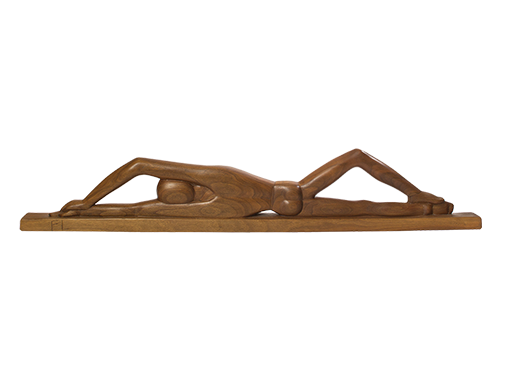
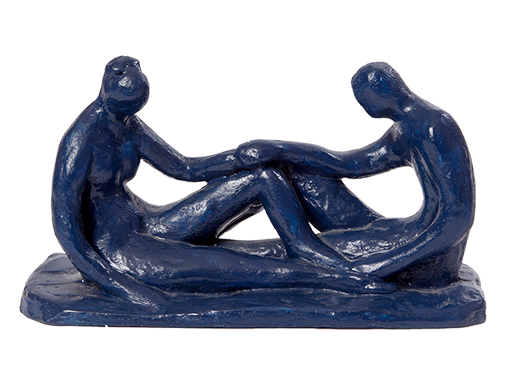
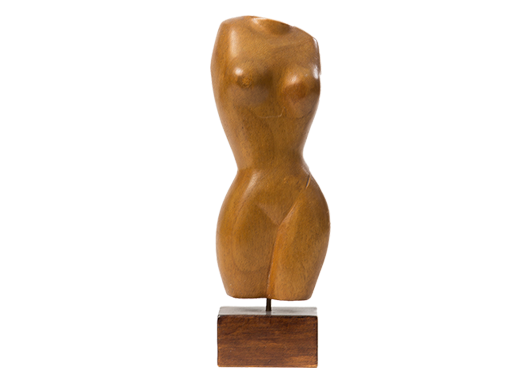

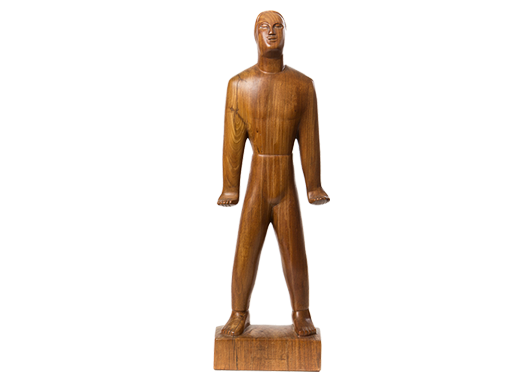
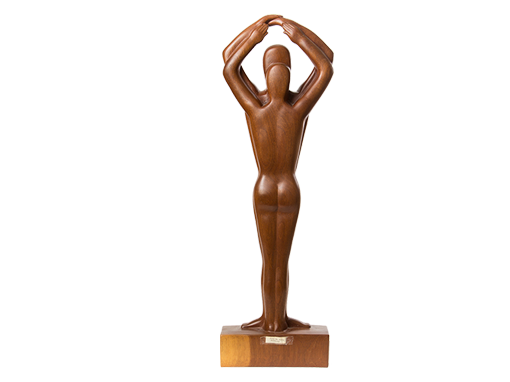
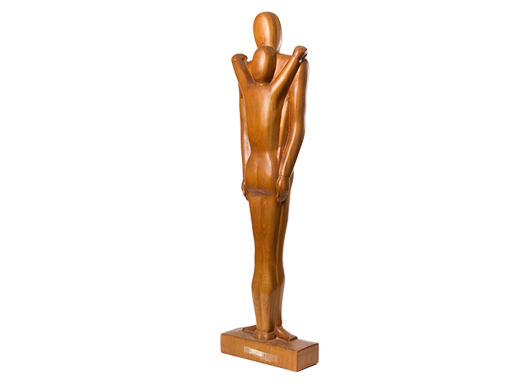
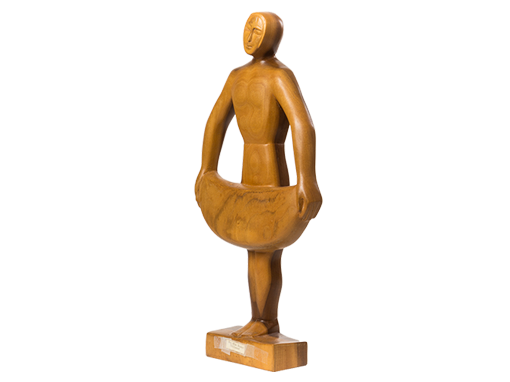
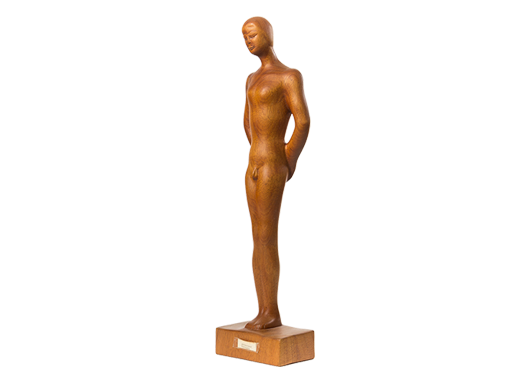





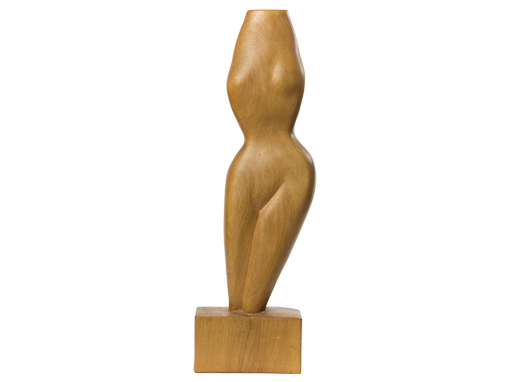
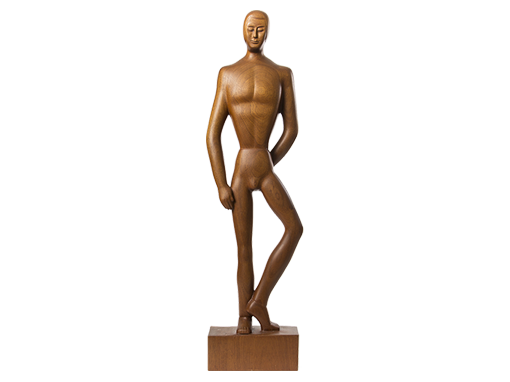
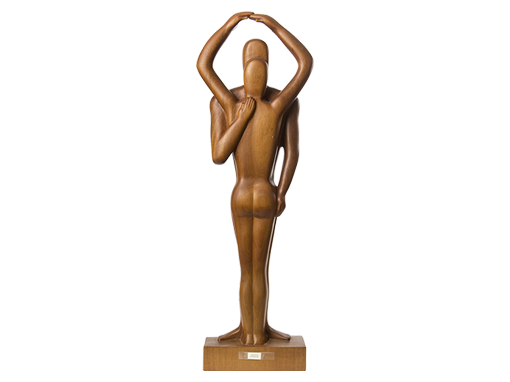
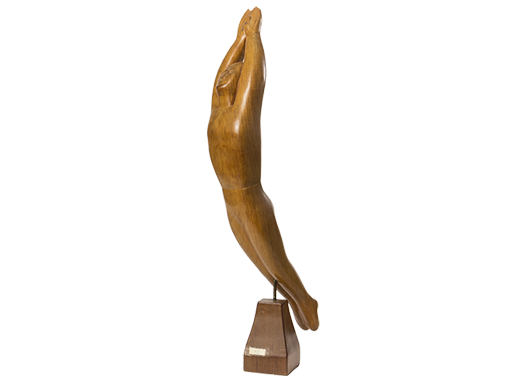
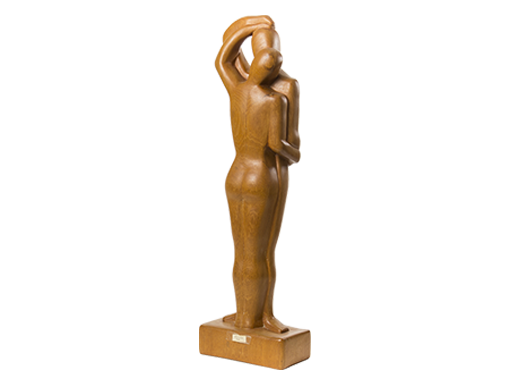
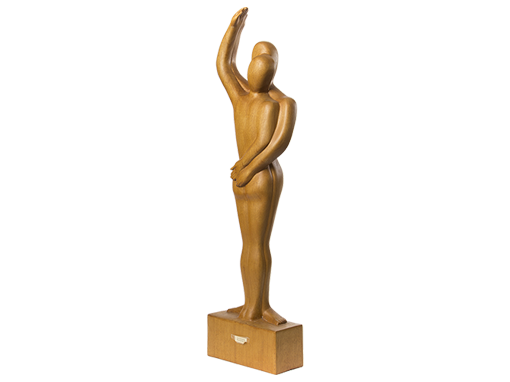
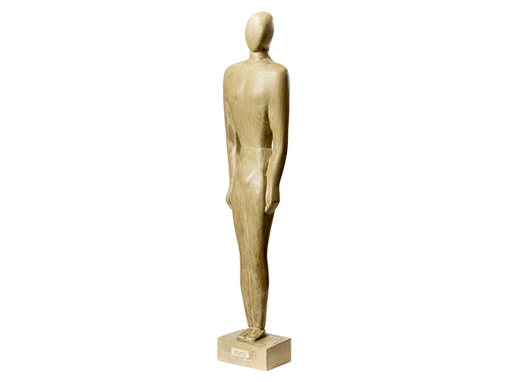
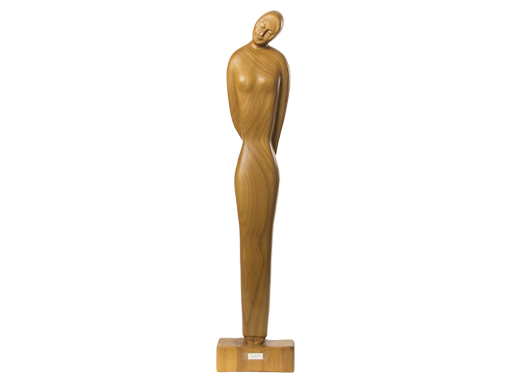
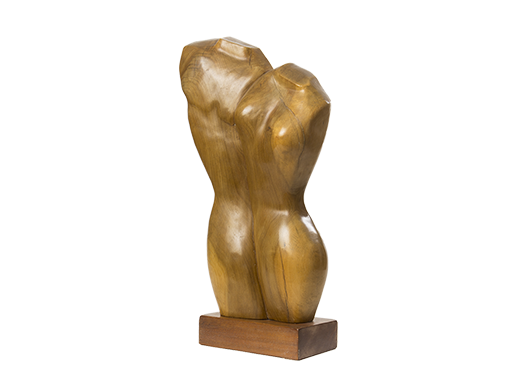
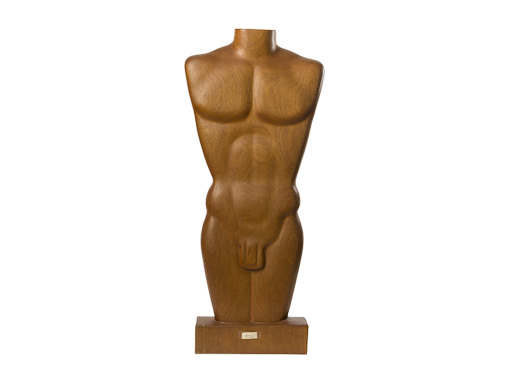

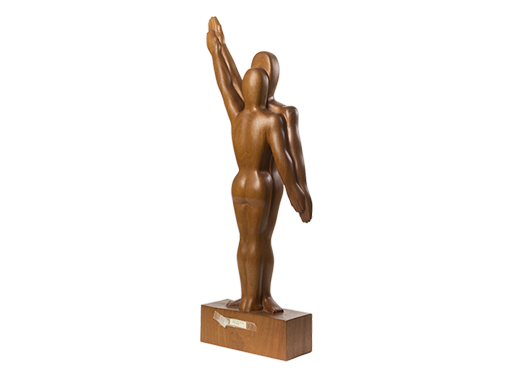


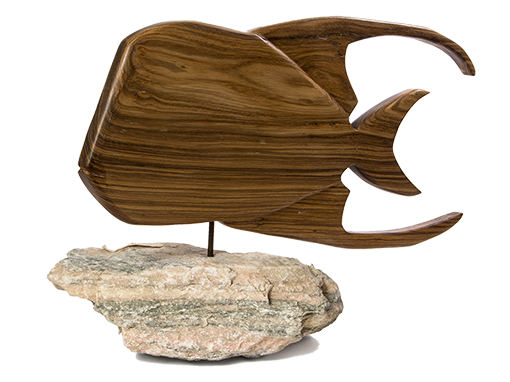

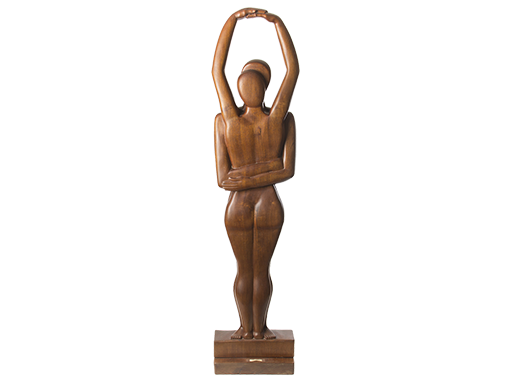

“In Fred Lancôme’s sculpture, representationalism is a vital part of his interpretation. However, through the use of smooth and undetailed surfaces, allowing the grain of the wood to be more apparent, he has evolved figures of great effect and power.”
